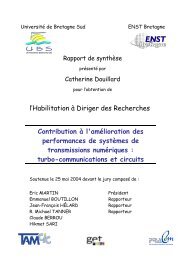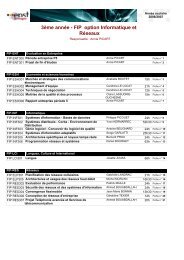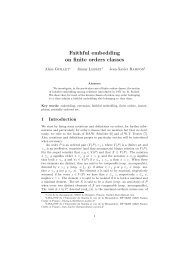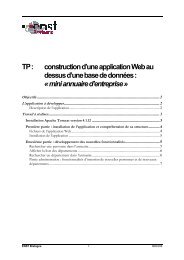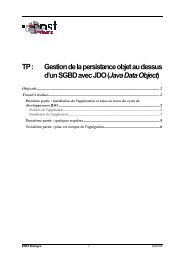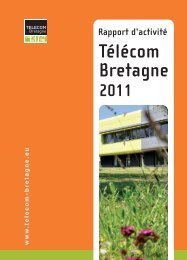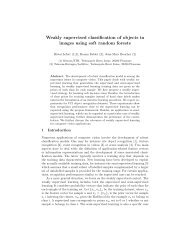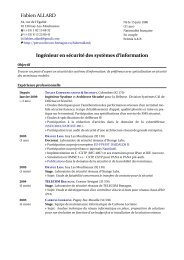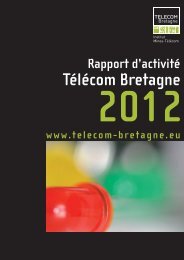researResearch - Télécom Bretagne
researResearch - Télécom Bretagne
researResearch - Télécom Bretagne
You also want an ePaper? Increase the reach of your titles
YUMPU automatically turns print PDFs into web optimized ePapers that Google loves.
esearc<br />
<strong>researResearch</strong><br />
130<br />
they are information needs or coordination<br />
needs.<br />
Uses and locations depend from the<br />
differentiation of business environments in the<br />
international context. But at the local level, we<br />
observe a different dependency based on a 3 step<br />
technical process “codification-informationcoordination”.<br />
Organization<br />
The organizational dimension of ICT uses was<br />
approached from two directions: one with<br />
respect to information systems (IS) and the other<br />
with respect to their imaginary dynamics.<br />
The IS projects were studied from two<br />
complementary angles, in two distinct research<br />
projects. The research first of all showed that the<br />
social capital of the various actors had an<br />
important impact on the details of how IS<br />
projects are carried out. A second study involved<br />
studying small and mid-sized businesses,<br />
particularly with respect to the Enterprise<br />
Resource Planning (ERP) software packages.<br />
Small businesses have certain unique<br />
characteristics because of their size that<br />
influence the architecture of their IS, compared<br />
to large corporations. A comparative analysis<br />
was made (between large corporations and small<br />
and mid-sized businesses) of the organizational<br />
risks and the expertise of the actors involved.<br />
ICT structures the organization around a technoeconomical<br />
model, but also brings out its<br />
imaginary dimension. It has become an<br />
important place for emotions to be shared:<br />
positive, as in general (lato sensu) projects, or<br />
negative, as with computer addiction. This was<br />
the subject of a special issue of the journal<br />
Gestion 2000, dedicated to ICT and Psyche ([1] de<br />
Swarte). The main idea is that ICT has become an<br />
important avenue for structuring the imaginary<br />
within the organization. According to a welltested<br />
trilogy of The Real-The Symbolic-The<br />
Imaginary, ICT, in addition to its communicative<br />
properties, has a symbolic dimension consisting<br />
of giving meaning to its uses. This theme was<br />
further developed in an article addressing the<br />
virtual-real pairing within the framework of a<br />
multimedia space for young people aged 15-25<br />
([2] de Swarte, in Gestion 2000), as much in its<br />
measurable and observable dimension as in its<br />
interpretation at the symbolic level.<br />
The junction between telecom uses and<br />
organizational theory, naturally complex, allows<br />
the UT project to study smaller companies or<br />
groups, thanks to the ICT "scanner".<br />
Evaluation<br />
We further developed our methodology for the<br />
evaluation of non-use, while at the same time<br />
studying the implication of businesses in the<br />
development of "freeware", independent of the<br />
large computer technology corporations.<br />
Previous work on "fishing and use" of ICT was<br />
published ([8] Boutet, chapter in Benedetto,<br />
Meyer, Chevallet). 2008 was a year of<br />
strengthening our methodology on the question<br />
of non-use, which was the subject of several<br />
conference presentations. Nothing within this<br />
domain is dichotomous, and the most<br />
stimulating research topics can be found in the<br />
heart of the user's habitus: the non-user<br />
constructs his or her practices just as much as<br />
the user constructs, deconstructs, and<br />
reconstructs his or hers. So the observation and<br />
determiners of this habitus count much more<br />
than can be measured, which could imply a<br />
"return" to more qualitative methods in the<br />
future. This method was also applied to the<br />
medico-social sector in the usage of ICT by<br />
handicapped or elderly people. In addition to<br />
adaptations of technical interfaces and adaptive<br />
services, the main sticking point for use remains<br />
the costs of these systems. So the main question<br />
becomes the following: Who is going to be<br />
responsible for financing these new systems, and<br />
under what economic model<br />
([7] Jullien et al., chapitre in L'argent, Université<br />
de Lille) explored the hypothesis that businesses<br />
get involved in freeware development<br />
communities because of their marketing position<br />
and the characteristics of their market. We tried<br />
to propose a typology of business models that<br />
would explain the differences in level of<br />
involvement in freeware development. We carried<br />
out an investigation of businesses in Frenchspeaking<br />
countries (France, Belgium and



